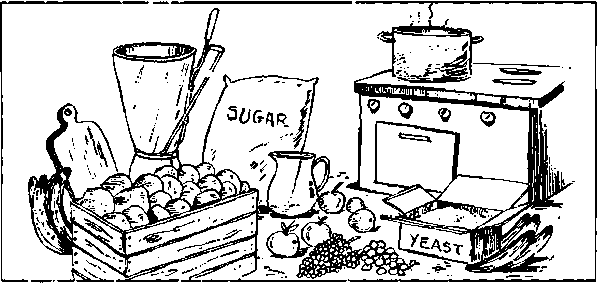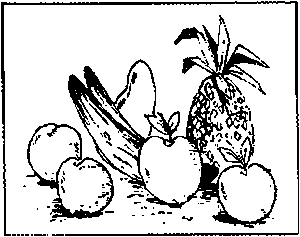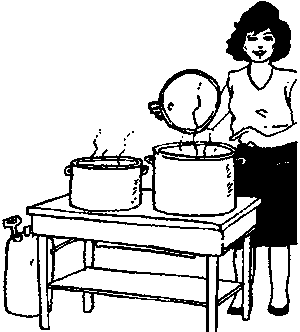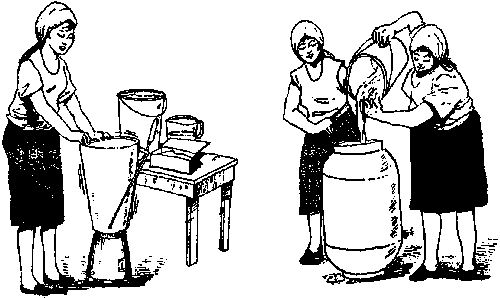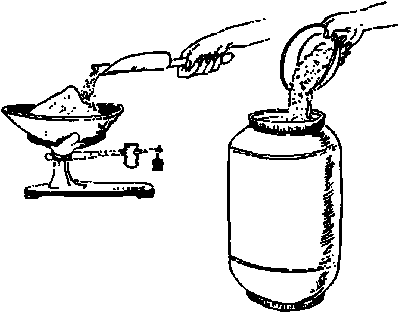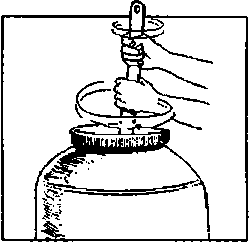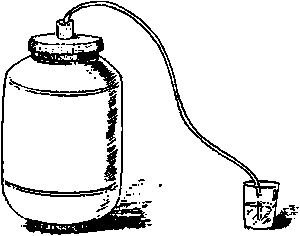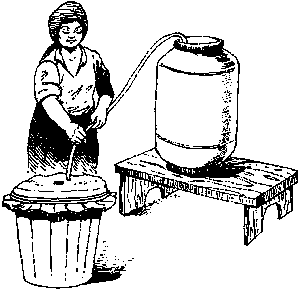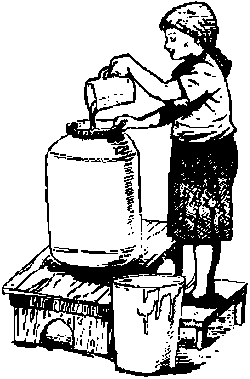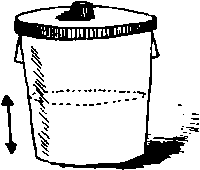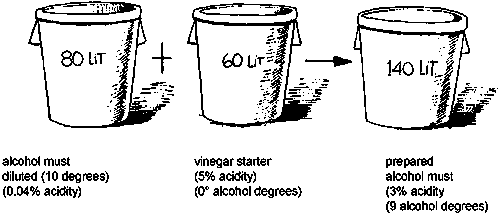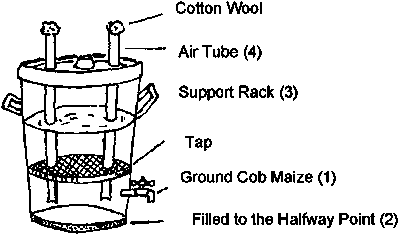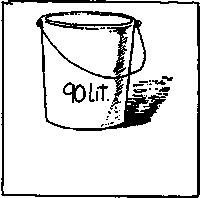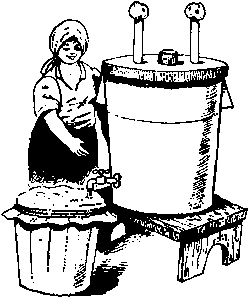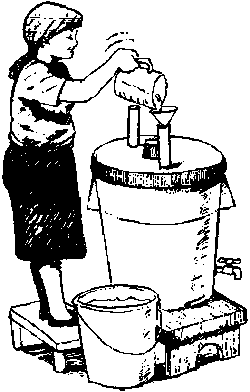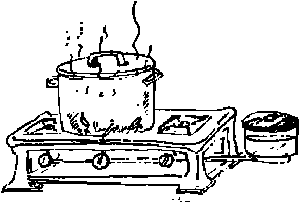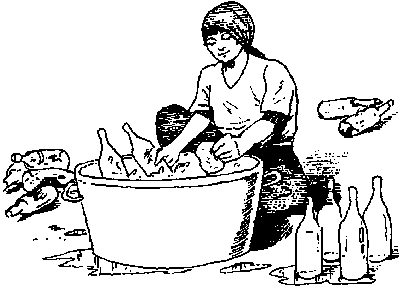Difference between revisions of "How to Make Fruit Vinegar"
(→Investment costs) |
|||
| Line 1,139: | Line 1,139: | ||
[[Category:Practical Action Update]] | [[Category:Practical Action Update]] | ||
[[Category:Practical Action Spanish]] | [[Category:Practical Action Spanish]] | ||
| − | [[Category:Requested translation to Spanish]] | + | [[Category:Requested translation to Spanish]] |
| + | |||
| + | {{French Translation}} | ||
Revision as of 13:30, 6 November 2012
Contents
Introduction
A wide range of seasonal fruits grow in Northern Peru but their seasonality causes problems for farmers through low prices and post-harvest losses. One option to better make use of this fruit is to produce a good quality competitively priced fruit vinegar for the local market. Only a small production unit is required costing about $US 3600 for equipment and materials. A working capital of $750 is needed to produce 350 litres of vinegar; equivalent to 778 bottles of 450 ml. (Prices as of 1991.)
The technology involved is quite simple. An industrial liquidiser is used to prepare the fruit must that is fermented and plastic containers are used for the two fermentations required (alcoholic and acetic). Bottling is done by hand. The plant's maximum capacity is 2,000 bottles (450 ml) per month. However all costs can be covered when producing just over 600 bottles per month.
Raw materials and equipment
The following items are needed to process 50kg of ripe banana and make 350 litres of white vinegar.
Raw materials
In this example we will use ripe bananas but a whole variety of fruits such as apples, pineapples and peaches etc. can be used when they are cheap.
Water
Boiled water must be used. During the process we used boiled that has been allowed to cool to dilute the liquidised fruit pulp. Each fruit is slightly different and so must be treated differently.
Yeast
Yeast is used for the alcoholic fermentation of the must. We use ordinary bread yeast to do this (1 gr. of yeast x 1 litre of prepared must.)
Vinegar starter - acetic acid producing bacteria
Vinegar that has not been pasteurised (heated to make it sterile) has an acetic acidity between 5% and 8% and contains live vinegar producing bacteria. It is used to start the acetic fermentation using 7 litres of vinegar starter for each 10 litres of corrected must.
Dry yellow corncobs
Coarsely ground corncobs are used in small quantities to speed up and increase the amount of acetic acid produced.
Sodium bisulphate
This is used to prevent contamination by other micro-organisms and also as a rinsing solution when washing bottles. (1 spoonful of bisulphate per litre of water)
Equipment and materials
|
teaspoon |
Here oxygen is essential. Vinegar for food use must contain between 4% and 5% acetic acid. The following page shows the main steps involved in the production of fruit vinegar.
The production process
The actual production takes two months. This is followed by 20 days in storage tanks.
Choosing and preparing raw material
Before beginning you must wash your hands and tie your hair back. You can now begin to make the ripe banana vinegar.
In this example, take 50 kg of ripe bananas.
Citric acid and sodium bicarbonate
Fruits have different acidity levels; some like the orange and mandarin are very acidic. Others like the banana or peach are less so. The acidity must be adjusted so that the yeast can properly grow during the alcoholic fermentation stage. Acidity is controlled by adding sodium bicarbonate to the very acid fruits and citric acid to fruit with little acid (see Recommendations for quantities to use for each fruit).
Sugar
Sugar is used to increase the fruit juice sugar concentration. 120 grams of sugar is used for every litre of diluted must.
Steps to follow
Vinegar is obtained after two fermentation stages. In the first stage, an alcohol fermentation takes place, where sugar is changed into alcohol. This takes place in the absence of oxygen (without air). In the second stage, acetic fermentation takes place and the alcohol is turned into acetic acid.
|
| Weigh & wash | Chop up and /or remove seeds and liquidise | Must conditioning, dilution with water, adjust sugar level | Activate yeast and add to must | Alcohol fermentation | Siphon | Obtain alcoholic must | Adjustment of alcohol must. Correct alcohol level. Dilute must with water, add vinegar starter | Adjust acidity | Obtain vinegar | Filter | Pasteurise | Bottle | Store | Market |
Weigh the fruit with peel on and then peel the bananas. You should then have 33 kg of peeled banana. 150 litres of water must be boiled, preferably the day before so that it has cooled to room temperature.
Preparing the Must
The peeled fruit is liquidised; this can also be done by hand using a masher. In either case, a little warm boiled water at about 70°C is added to stop the pulp discolouring. Next measure the quantity obtained (65 litres in this example) and pour it into the fermentation barrels. The other necessary ingredients will be added later.
A. Dilution of the fruit pulp with water
For every litre of pulp obtained add 2 litres of cold boiled water (see recommendations)
|
Therefore: |
1 litre pulp - 2 litres water |
|
65 litres pulp - 130 litres water |
Total must volume = 65 litres (pulp) + 130 litres (water) = 195 litres of diluted must (diluted)
B. Sugar adjustment
After diluting the must with water, the sugar concentration has decreased. Therefore, it is necessary to add 120 gr. of sugar per litre of total of diluted must. For each litre of must 120 gr. of sugar is required. Therefore, 195 lt. of must will require 23.50 kg. of sugar.
C. Acid correction
In the case of banana, citric acid has to be added (see recommendations).
In this example, half a teaspoon of citric acid per 10 litres must is required.
Yeast activation
For the alcohol fermentation, we use 1 gr. of bread yeast per litre of must. So, we will need to dissolve 195 gr. of yeast in the 195 lt. of must. But first the yeast needs to be activated.
Place the yeast in a glass containing warm water, must and sugar. Mix it well and leave it in a warm place (30°C) for 15 - 20 minutes. The yeast is activated when bubbles appear on the surface.
Preparing must
Use half a glass of water + 1 teaspoon of sodium bisulphate.
warm boiled water ~ 1 gr. yeast/lt. must ~ put in warm place
Starting the alcoholic fermentation
Add the activated yeast to the corrected must and stir it with the wooden stirrer. Hermetically seal the container and connect a fermentation lock in the top.
The fermentation lock consists of a cork with a hole in the centre through which passes a 5mm diameter plastic tube. This must end up in the glass, which contains a small spoonful of bisulphate in half a glass of water.
Siphoning
After 20 days of alcoholic fermentation, the upper portion is siphoned off to separate the yeast residue and fruit pulp at the bottom of the container. To do this use another container covered with a piece of cloth on top of which there are two layers of cotton, as shown in the picture
The alcohol must is returned to clean containers to next be used in the acetic fermentation
To start the acetic fermentation, the alcohol content and the acidity of the siphoned must needs to be corrected. Also, it is recommended that containers used should have plenty of free space in them to give better oxygenation during the acetic fermentation.
In this case we use a 250 litre container but will only fill it with 140 litres of alcoholic must.
Preparing alcohol must
A. Correcting alcohol level
Once the siphoned alcoholic must is obtained we separate a quantity (20 lt.) and dilute it with 60 lt. of cold boiled water, i.e. 3 litres of cold boiled water per 1 litre of must. By doing this we lower the alcohol content.
B. Correcting acidity
The vinegar starter is next added to the diluted alcoholic must and the conversion of the alcohol into acetic acid. Unpasteurised vinegar (the starter) is added in the following proportions: 7 litres of starter vinegar per 10 litres of diluted alcohol must. This increases the acidity of the must.
7.0 litres of vinegar starter are needed for every 10 litres of alcohol must So, for 80 litres of alcohol must 56 litres of starter vinegar should be used.
Acetic fermentation
Fermentation equipment
First, the acetic fermentation equipment must be got ready. This must have a thin layer of ground maize cobs at the bottom of the container (1). It is then filled with the prepared alcoholic must to the 160 litre mark when using a 250 litre vessel. The support grille (3) is then put in place. This grille is made from a ring of non-resinous wood with the central part covered with nylon mesh. Plastic tubes (4) pass through the cover and the support grille. These are needed to supply air to the must.
The initial acetic fermentation takes 60 days. After about 18 days, a whitish layer or skin appears on the surface or on the wooden support. From this moment the acidity begins to increase reaching approximately 5% acetic acid during the remaining days.
Obtaining the vinegar
After the required number of days of acetic fermentation and the white layer has formed on the surface; as a thickish gelatinous skin; the vinegar reaches 5% acidity. The next steps are to:
1: Separate 20 litres of vinegar with approximately 5% acetic acidity into a container.
2: Add 100 litres more of prepared alcoholic must to the remaining 70 litres of vinegar.
How do we obtain this prepared alcohol must?
50 litres of alcoholic must + 50 litres of cooled boiled water = 100 litres prepared alcohol must
At this stage - obtaining the vinegar and adding more prepared alcohol must is carried out every 20 days.
Filtering
The vinegar is filtered after being separated from the fermentation equipment. The filter is a layer of cloth with two layers of cotton wool placed over the container.
Pasteurisation
The filtered vinegar is heated to 80°C for 15 to 20 minutes, to avoid contamination and the development of more acid.
Bottle preparation
While the vinegar is filtering, the bottles can be selected and washed. As the bottles used are second-hand, they must be soaked in detergent and one small spoonful of caustic soda. Then, rinse with 1 small spoonful of bisulphate per 10 litres of water. Finally, stand them to drain.
Bottling
A clean funnel is used to fill the bottles and they are corked by hand. For better presentation, put a plastic shrink sleeve over the cork.
Use 450 or 250 ml clear bottles.
Marketing
We can sell our fruit vinegar in 450cc to 250 ml containers in the following ways:
1 Directly in the market or to family and friends.
2 Through shops, provided that we have obtained the required industrial and health registration for our products.
(Water/fruit pulp)
Recommendations
1. If using other types of fruit, the following points will need to be taken into account:
Dilution
|
Fruit |
Dilution |
|
Peach vinegar |
1.5/1.0 |
|
Apple vinegar |
1.5/1.0 |
|
Pineapple vinegar |
1.5/1.0 |
|
Melon vinegar |
3.0/1.0 |
|
Soursop vinegar |
2.0/1.0 |
Acidity Correction
|
Peach must |
1 small teaspoonful of citric acid/ 10 litres of must |
|
Apple must |
1 small teaspoonful of bicarbonate/10 litres of must |
|
Pineapple must |
1 small teaspoonful of bicarbonate/10 litres of must |
|
Melon must |
1 small teaspoonful of citric acid/10 litres of must |
|
Soursop must |
1 small teaspoonful of bicarbonate/10 litres of must |
2. The vinegar can be used other products such as pickles, mustard or as a condiment.
3. The solids remaining obtained in the alcohol fermentation, after siphoning can be used in the next alcoholic fermentation.
4. The use of a specific gravity spindle gives a better control over the alcohol fermentation process.
Investment costs
The following equipment will be needed to produce 350 litres of vinegar a month (778 bottles of 450 mls):-
(All prices are in $US in force on the 23rd July 1991. The rate of exchange was 1$ dollar = 0.810 soles).
We needed 3 workers.
A. Costs of establishing the business
Preparing the production room, licences and registration - $46.47
B. Cost of equipment and materials
|
|
|
|
|
| |
|
cooker semi-industrial |
185.00 |
1 |
185.00 |
8 |
23.10 |
|
pan scales |
170.00 |
1 |
170.00 |
7 |
24.20 |
|
calculator |
7.50 |
1 |
7.50 |
5 |
1.50 |
|
industrial liquidiser (cap. 20 lts) |
1200.00 |
1 |
1200.00 |
10 |
120.00 |
|
buckets (cap. 15 lts) |
1.40 |
3 |
4.20 |
3 |
1.30 |
|
plastic vats (cap. 150 lts) |
25.00 |
2 |
50.00 |
4 |
12.50 |
|
knives/spoons |
1.50 |
6 |
9.00 |
5 |
1.80 |
|
tubing |
0.80 |
6 |
4.80 |
2 |
2.40 |
|
funnels |
0.45 |
5 |
2.25 |
3 |
0.75 |
|
measuring jugs |
1.20 |
2 |
240.00 |
4 |
0.61 |
|
plastic vats (250 lts) |
49.00 |
4 |
196.00 |
4 |
49.00 |
|
aluminium pans (60 lts) |
60.00 |
2 |
120.00 |
5 |
24.00 |
|
chopping boards |
2.50 |
3 |
7.50 |
3 |
2.50 |
|
baths |
3.70 |
2 |
7.40 |
3 |
2.46 |
|
tables |
37.00 |
2 |
74.00 |
8 |
9.30 |
|
plastic tubes |
0.60 |
2 |
1.20 |
2 |
0.60 |
|
wooden stands |
12.30 |
2 |
24.60 |
4 |
6.15 |
|
fermentation locks |
0.40 |
4 |
1.60 |
3 |
0.53 |
|
densimeter (0 -1.80) |
15.00 |
2 |
30.00 |
3 |
10.00 |
|
thermometer (0 - 150°C) |
12.00 |
1 |
12.00 |
3 |
4.00 |
|
$ |
2134.45 |
$ |
302.95 |
C. Fixed costs (per month)
|
$ | |
|
Renting premises |
30.78 |
|
admin materials |
16.20 |
|
light, water etc. |
12.15 |
|
depreciation |
27.50 |
|
personnel (management, sales, purchases) |
123.50 |
|
insurance, registering etc |
12.00 |
|
repairs and maintenance (equipment, premises) |
12.50 |
|
$232.38 | |
|
Miscellaneous (10%) |
23.46 |
|
Total fixed costs |
$255.62 |
D. Variable or production costs
These are the expenses and quantities necessary to produce one 450 ml bottle of vinegar.
|
expense ($) |
price per unit ($) |
total cost ($) | |
|
Raw material (banana) (Kg) |
0.1420 |
0.120 |
0.0017 |
|
Labour (day) |
0.0200 |
1.850 |
0.0370 |
|
Yeast (g) |
0.4500 |
0.004 |
0.0020 |
|
Sodium bisulphate (kg) |
0.0001 |
2.500 |
0.0003 |
|
Vinegar starter (lts) |
0.6850 |
0.240 |
0.1640 |
|
Sugar (kg) |
0.0680 |
0.500 |
0.0340 |
|
Citric acid (g) |
0.1000 |
0.003 |
0.0003 |
|
Bottles (450 cc) |
1.0000 |
0.050 |
0.0500 |
|
Plastic tops (unit) |
1.0000 |
0.020 |
0.0200 |
|
Cap sleeves |
1.0000 |
0.030 |
0.0300 |
|
Labels |
1.0000 |
0.008 |
0.0080 |
|
kerosene (gal) |
0.0140 |
1.450 |
0.0200 |
|
cotton (pack) 500 g |
0.0080 |
1.300 |
0.0100 |
|
Water (lts) |
0.4280 |
0.220 |
0.0940 |
|
$ 0.4866 | |||
|
Marketing costs (10%) |
0.0487 | ||
|
Miscellaneous (10%) |
0.0535 | ||
|
$ 0.5888 |
To produce different quantities eg 778 (450 cc) bottles (or 350 litres of vinegar) we need
- banana 778 x 0.142 = 110 kg of banana
- sugar 778 x 0.068 = 52.90 Kg of sugar
and so on for every ingredient.
Break even production
Knowing the variable costs per bottle ($ 0.59) and the sale price per bottle of vinegar (1.01) we can calculate the production quantity which will be equal to the total monthly income plus costs (break even production) i.e. one neither gains or loses money when producing this amount of vinegar.
In our example:
Profitability of the plant
|
Monthly volume of production (bottles) (450 cc) |
Percentage use of capacity (%) |
Total earnings of the plant ($ US) |
Total income per person/month ($US) |
|
609 (break even) |
31 |
0.00 |
7.59 |
|
778 |
39 |
68.64 |
9.60 |
|
2000(max. cap.) |
100 |
581.70 |
24.67 |
|
Total Investment for Plant | ||
|
A) Setting up costs |
$ |
146.47 |
|
B) Costs of equipment and materials |
$ |
3109.45 |
|
C) Fixed costs |
$ |
255.62 |
|
D) Variable costs (4 weeks) + (50 kg. of fruit) |
$ |
465.02 |
|
Total |
$ |
4379.58 |
References and further reading
• Fermented Fruits and Vegetables: A Global Perspective, FAO, 1998
• Vino de Frutas: Serie Procesamiento de Alimentos 6, ITDG Latin America, 1998
• Grape Wine, Practical Action Technical Brief
• Fruit Juice Processing, Practical Action Technical Brief
• Fruit and Vegetable Processing: Food Cycle Technology Source Books, UNIFEM, 1993
|
This document has been translated from Vinagre de Fruita: Serie Procesamiento de Alimentos 2, ITDG Latin America, 1992 Practical Action Latin America |
Categories
- Pages with broken file links
- Agriculture
- Commercial
- Community
- Cooking
- Cooling
- Food Processing
- Fruits
- Products
- Small Business
- Easy to Medium
- Local Technology
- Rural Environment
- Temperate Climate
- Tropical Climate
- Urban Environment
- More than 200 US$
- Banana
- One Person and more
- Household
- Village
- Neighbourhood
- Practical Action Update
- Practical Action Spanish
- Requested translation to Spanish
- Being translated to French
